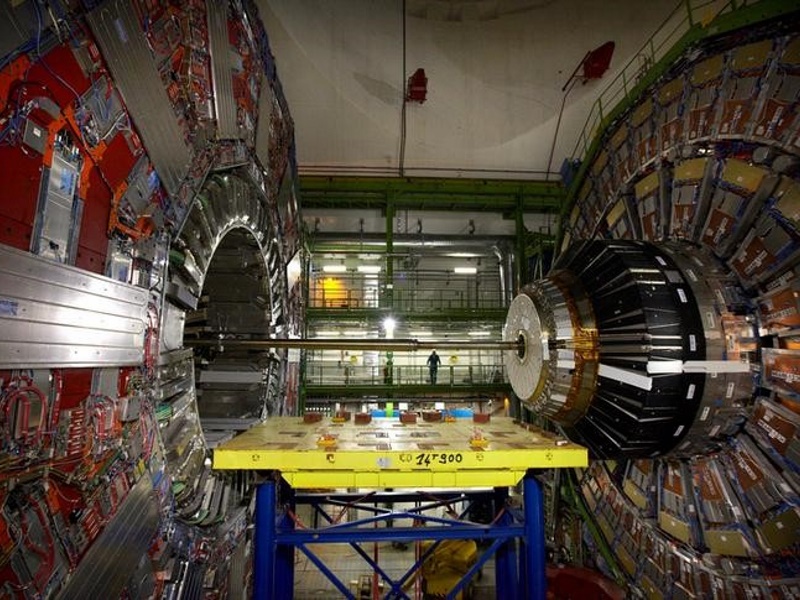- Home
- Science
- Science News
- Physics Prepares to Feast on Collider Data, Seeking Dark Universe
Physics Prepares to Feast on Collider Data, Seeking Dark Universe

"In the life of accelerator physics there are few moments like the one we are living through," said Tiziano Camporesi, leader of the CMS experiment at Cern.
"This is the time when the probability of finding something new is highest."
The Higgs boson, whose discovery secured the Nobel prize for physics in 2013, answered fundamental questions about how elementary matter attained mass. But it did not solve the riddle of what's missing from the "standard model" of physics.
The standard model, an elegant ensemble of equations summarising everything known about nature, leaves some questions hanging, Camporesi told Reuters at Cern in Geneva.
One puzzle is why gravity doesn't seem to fit into the standard model. Another question is why there is far more matter in the universe that the 4 percent we can see.
The LHC has never worked better, or harder. Billions of protons shoot around the 27-km (17-mile) underground ring before smashing into each other at an energy of 13 Tera electron Volts (TeV), or about 13 times the force of a flying mosquito. The intensity of the proton beams has been cranked up to a record, providing more data than ever.
Cern scientists count their huge volumes of data in "inverse femtobarns". They harvested 2.6 last year and have culled almost 8 already this year, Camporesi said.
The big reveal will be at the International Conference on High Energy Physics in Chicago next month when CMS and its neighbour at Cern, the Atlas experiment, will show what they have found.
There was a first hint of a possible result last December, when CMS and Atlas both suggested a "bump" in the data at 750 Giga electron Volts (GeV).
Within two weeks, there were 89 papers theorising what it could be. Now there are 450. But Camporesi urged caution, and said theorists could be trigger-happy.
"What we have seen is like if you had thrown a coin six times and see that it always comes out heads. You wouldn't bet that the coin has two heads just on that," he said.
"Nature can be kind, or it can be subtle. If it is kind, the discoveries come quickly."
If it is subtle, it could take all of the LHC's planned 3,000 inverse femtobarns to produce a result.
"I'm afraid that dark matter might be something that is much, much rarer than the Higgs boson," Camporesi said.
© Thomson Reuters 2016
Get your daily dose of tech news, reviews, and insights, in under 80 characters on Gadgets 360 Turbo. Connect with fellow tech lovers on our Forum. Follow us on X, Facebook, WhatsApp, Threads and Google News for instant updates. Catch all the action on our YouTube channel.
Related Stories
- Samsung Galaxy Unpacked 2025
- ChatGPT
- Redmi Note 14 Pro+
- iPhone 16
- Apple Vision Pro
- Oneplus 12
- OnePlus Nord CE 3 Lite 5G
- iPhone 13
- Xiaomi 14 Pro
- Oppo Find N3
- Tecno Spark Go (2023)
- Realme V30
- Best Phones Under 25000
- Samsung Galaxy S24 Series
- Cryptocurrency
- iQoo 12
- Samsung Galaxy S24 Ultra
- Giottus
- Samsung Galaxy Z Flip 5
- Apple 'Scary Fast'
- Housefull 5
- GoPro Hero 12 Black Review
- Invincible Season 2
- JioGlass
- HD Ready TV
- Laptop Under 50000
- Smartwatch Under 10000
- Latest Mobile Phones
- Compare Phones
- OnePlus Ace 6T
- OPPO A6x 5G
- Samsung Galaxy Z TriFold
- Poco F8 Ultra
- Poco F8 Pro
- Huawei Mate 80 RS Master Edition
- Huawei Mate 80 Pro Max
- Huawei Mate 80 Pro
- Asus ProArt P16
- MacBook Pro 14-inch (M5, 2025)
- Poco Pad M1
- Poco Pad X1
- Just Corseca Skywatch Pro
- Honor Watch X5
- Acerpure Nitro Z Series 100-inch QLED TV
- Samsung 43 Inch LED Ultra HD (4K) Smart TV (UA43UE81AFULXL)
- Asus ROG Ally
- Nintendo Switch Lite
- Haier 1.6 Ton 5 Star Inverter Split AC (HSU19G-MZAID5BN-INV)
- Haier 1.6 Ton 5 Star Inverter Split AC (HSU19G-MZAIM5BN-INV)

















